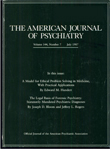Brainstem evoked response abnormalities in late-life depression with vascular disease
Abstract
OBJECTIVE: The purpose of this study was to examine whether the brainstem evoked responses of geriatric depressed patients with vascular disease show greater changes in wave V latency after increased stimulation than do responses of geriatric depressed patients without vascular disease and elderly comparison subjects with and without vascular disease. METHOD: Geriatric patients with unipolar depression (N = 53) were recruited from a university psychiatric hospital. Elderly comparison subjects (N = 23) were recruited through advertisements. All subjects were assessed for depressive symptoms, cognitive performance, overall medical burden, vascular disease, and disability. Brainstem evoked response was elicited at stimulation rates of 11.4 and 80.0 clicks/sec. RESULTS: The interaction between depression and vascular disease had a significant effect on change in wave V latency. This effect was synergistic, more than an additive effect. Post hoc comparisons showed that the depressed patients with vascular disease had greater changes in wave V latency that did the depressed patients without vascular disease, comparison subjects with vascular disease, and comparison subjects without vascular disease. Linear discriminant function analysis showed that 82% of the subjects with abnormal changes in wave V latency (sensitivity: 75%, specificity: 81%) could be identified on the basis of ratings for depression and vascular disease. CONCLUSIONS: Demyelination afflicting the pons and mesencephalon may explain the greater change in wave V latency for the brainstem evoked response in depressed patients with vascular disease. Further studies combining brainstem evoked response with brain imaging may determine whether depression develops only after vascular disease leads to demyelination.



